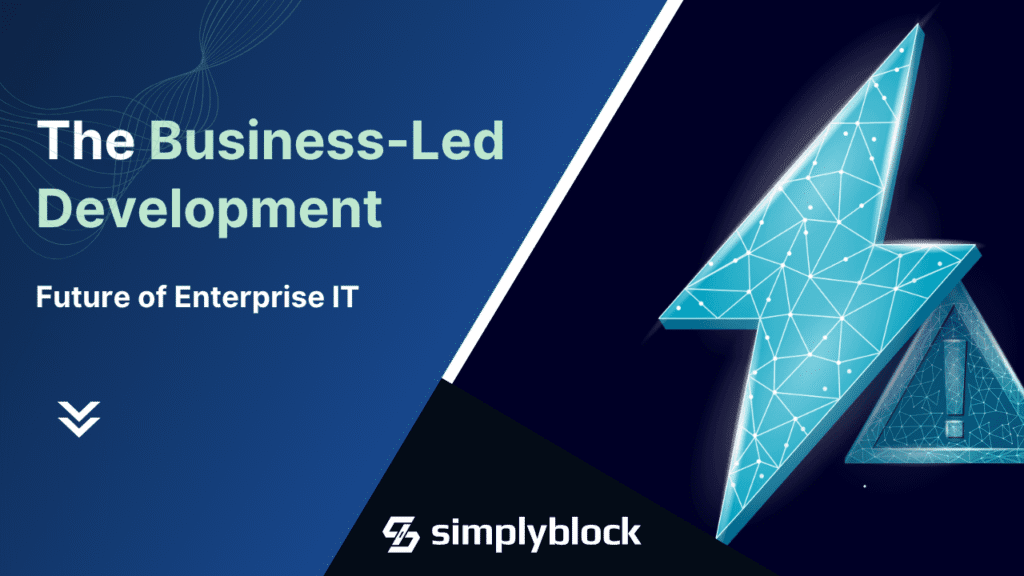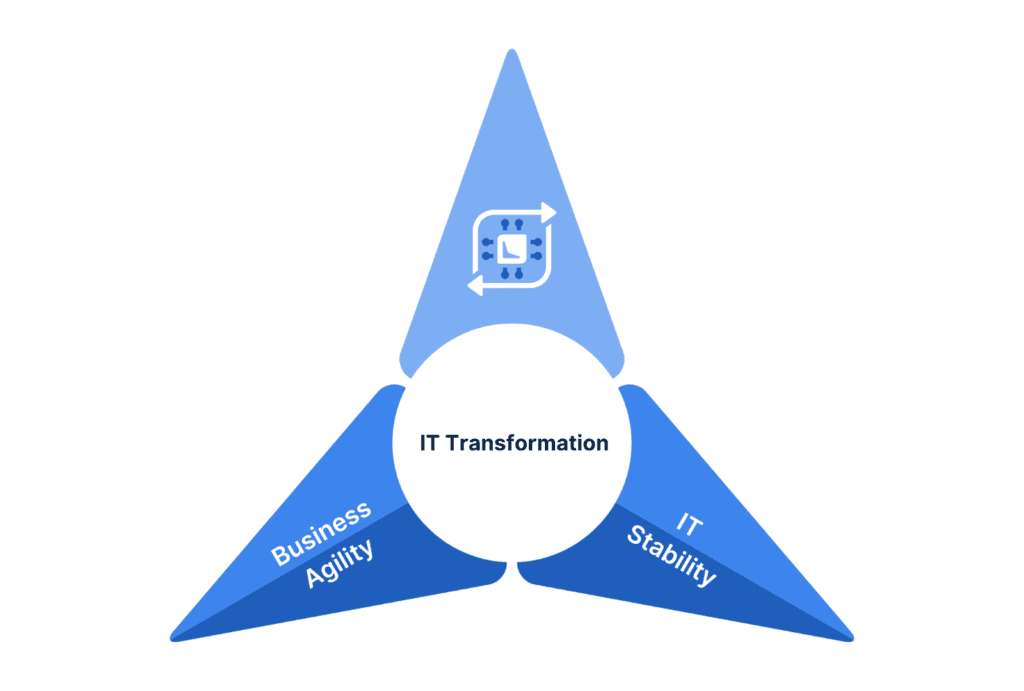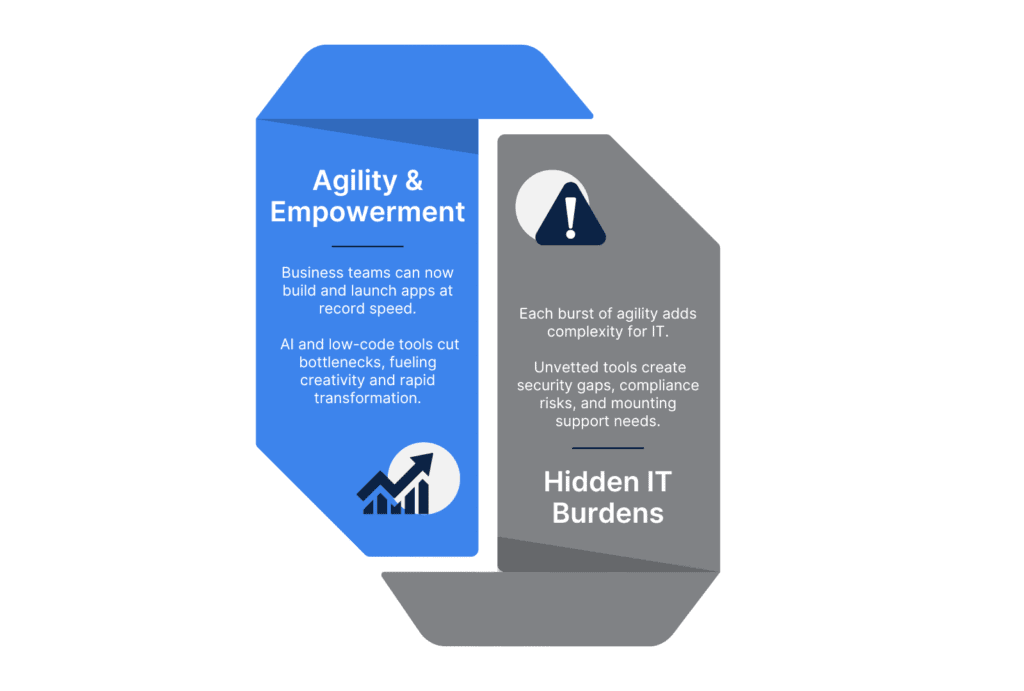Business-Led Development: A Double-Edged Sword for Enterprise IT
Oct 09th, 2025 | 7 min read

The enterprise IT department has long walked a tightrope between enabling innovation and preserving stability. Today, with generative AI and low-code/no-code tooling, that balance is under extreme tension. Business groups—from marketing to operations—now have the power to design and launch their own functional apps in days instead of months.
At first glance, this shift seems to supercharge digital transformation and accelerate enterprise IT modernization. But underneath it lies a growing pressure on IT to absorb unanticipated risks, costs, and integration complexity.

The Promise of Democratized Development
Recent tools have dramatically lowered the barrier to building software. Platforms like Lovable, Replit, or Bolt allow non-engineers to spin up dashboards, workflows, or small apps simply by describing their needs in natural language or assembling blocks. Business leaders like this autonomy, because problems can be solved immediately rather than waiting weeks for backlog scheduling.
In practice, a marketing manager might ask for a campaign dashboard and get a working prototype in one day. A finance team might generate a forecasting tool with internal data fused from ERP systems. A product team might model and expose an internal API for customer analytics. All of this happens with little to no initial dependence on central IT.
This dynamic is part of a broader shift: technology becomes more of a business capability than an IT output. Rather than “IT builds everything,” organizations evolve toward business-led development—where technology is a tool in every team’s toolkit.
The Hidden Burdens that Fall Back on IT
As these business-built tools begin to touch real operations, they inevitably expose problems that only IT traditionally handles. First, performance and scalability become a concern. A tool built by a small team might work well for ten users, but when scaled across departments, it often collapses under load. IT must then step in, refactor or rearchitect, and optimize infrastructure.
Second, security and compliance are rarely accounted for by business builders. An independently deployed portal may store sensitive data without encryption, bypass corporate authentication, or violate GDPR or industry rules. IT is forced to retrofit governance, enforce policies, and remediate vulnerabilities.
Third, availability and support cannot be postponed. Once a tool becomes essential to workflows, any downtime is felt organization-wide. IT inherits support responsibilities, integration demands (e.g. connecting with SSO, identity, logging), and SLAs.
Fourth, cost management becomes an issue. Business-built tools frequently ignore infrastructure efficiency, licensing, or resource duplication. IT eventually must consolidate, rationalize, and enforce cost controls.
All together, the narrative becomes ironic. Business users gain agility, but IT ends up absorbing the financial, operational, and risk burden.

Why IT Teams Feel the Squeeze
This is not merely a new iteration of shadow IT. Traditionally, shadow IT meant departments adopting unauthorized SaaS apps. Now, generative tools allow non-technical staff to produce fully functioning applications on their own. These are not trivial scripts, but complete, deployable systems.
Because these tools scale quickly, IT cannot simply block them. If business leaders can deliver value without waiting, they will. IT is left in the position of reactive custodian. As demand surges, backlog grows, and complexity deepens, IT teams become firefighting squads. Meanwhile, digital transformation goals strain under this hidden load.
As enterprises drive toward broader enterprise IT transformation, IT’s role must evolve. Instead of being gatekeeper, IT must become enabler — shaping how self-service digital innovation safely happens at scale.
Building Guardrails Rather Than Barriers
Effective IT leaders are not resisting business-led development. They are harnessing it. The goal is to create safe spaces where innovation flourishes under a corporate blueprint.
IT must embed governance frameworks that apply to all applications, whether built by developers or business teams. These frameworks ensure data access, authentication flows, encryption, auditing, and regulatory compliance are non-negotiable constraints.
Platform engineering bridges that gap. Rather than managing each ad hoc app, IT can build internal platforms or internal developer platforms (IDPs) that pre-embed enterprise guardrails. Teams can self-serve in these platforms, deploying apps that conform automatically to best practices for performance, security, and deployment.

In fact, modern IT transformation strategies increasingly rely on platform engineering to scale productivity and consistency. Platform engineering enables teams to build while enforcing standards and reducing risk. However, platform teams oftenwise do not take end-to-end responsibility for developer or corporate user experience – especially when it comes to database experience.
IT can also adopt AI-assisted oversight tools. These tools automatically review generated code, flag vulnerabilities, and monitor usage patterns. Rather than manual reviews, AI becomes part of the governance engine.
Another essential approach is education and collaboration. IT must position itself as a partner rather than a gatekeeper. Offering training, templates, and guidance helps business teams act responsibly. Cohesive partnership avoids confrontational friction and fosters shared accountability.
As IT’s role shifts, the function becomes one of platform curator and standards guardian, rather than solitary engineer.
Business-Led Development in Practice
Imagine marketing leaders using Lovable to generate a campaign tracking dashboard that hooks into Salesforce and digital ad APIs. It works for a pilot, but when hundreds of users begin querying historical data, it slams against latency issues. IT must redesign the data layer, insert proper indexing, and migrate it to a scalable database platform.
A finance team might build a P&L forecasting tool on Replit. It works for one department, but fails to account for encryption or proper API credential management. When leadership mandates its adoption across business units, IT must migrate it into a secure environment, integrate it with identity systems, and ensure audit trails.
A product group might use Bolt.new to spin up an internal customer behavior portal. Adoption is fast, but integration with corporate single sign-on and observability is missing. IT must retrofit authentication, logging, metrics, and resilience before it can go live.
Each of these scenarios follows a similar pattern: rapid innovation, followed by gradual IT rescue.
Turning Pressure into Strategic Opportunity
The most successful organizations do not try to block business-led development. Their success comes from accepting the trend and building a structure around it. IT’s new identity becomes the steward of enterprise resilience and guardrails. By enabling safe, scalable business-driven development, IT becomes a strategic enabler rather than a bottleneck.
Modern platforms like Vela’s Postgres Data Platform show how this balance can work in practice. Vela provides instant database branching, row-level security (RLS), isolated environments, and built-in governance so business teams can self-serve without compromising enterprise standards. For platform engineers, this means no longer stitching together fragmented services, custom scripts, and manual workflows to keep pace with business demands. Instead, they gain a unified toolset that enables organizational agility without adding operational complexity. IT can stay in control of cost, performance, security, and compliance, while business units innovate freely on top of a safe, scalable foundation.
In this model, business-led development is not a threat. It is a channel for enterprise innovation—if managed well.
Calculate how much your IT team could save with database branching using Vela’s Savings Calculator.
The Future of Enterprise IT’s Role
Business-led development is not a passing trend. Generative tools will only accelerate the pace and power of self-service applications built outside traditional IT. The question is no longer “Can we stop it?” but “How do we harness and govern it effectively?”
That challenge defines modern enterprise IT transformation. IT must evolve from builder to orchestrator, shifting focus toward building internal platforms, embedding governance, automating oversight, and partnering directly with business teams. In this new model, IT is less about delivering every application and more about safeguarding enterprise resilience.
Enterprises that embrace this mindset will strike the right balance between innovation, governance, and speed. They will ride the wave of democratized development instead of being overwhelmed by it. And their IT departments will succeed not by blocking AI-powered innovation, but by embracing a platform-first governance model that ensures every application—no matter who builds it—meets the standards of performance, security, availability, and cost efficiency.



